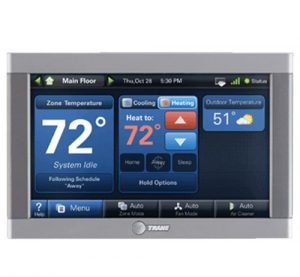A heat pump reversing valve is an essential component of a modern heat pump system.
It works by switching the refrigerant flow between the evaporator and condenser coils, allowing it to reverse operation from cooling mode to heat mode and vice versa.
This simple mechanism helps improve the efficiency of heat pumps while providing greater control over its temperature settings.
In this article, we’ll discuss how a heat pump reversing valve works, its components, and its benefits. We’ll also give you a couple of maintenance tips to keep it working smoothly.
By understanding all these aspects of the reversing valve, you can ensure that your heat pump performs optimally for years to come.
Read on to learn more about your heat pump system.
What is a Heat Pump Reversing Valve and How Does It Work?
Reversing valves for heat pumps are small cylindrical devices that are inside the heat pump system.
It works by controlling the refrigerant flow between the outdoor coil and indoor coil, allowing it to switch between modes.
When you switch your heat pump system into cooling mode, the reversing valve opens up and allows the refrigerant to flow out of the evaporator coil and into the condenser coil.
This helps cool down your home by dissipating heat from inside it.
When you switch your heat pump system into heating mode, the reversing valve closes off the supply of refrigerant coming from the evaporator coil.
After, it opens up the supply to allow refrigerant to flow from the condenser coil into the evaporator coil.
This helps heat up your home by absorbing heat energy from outside of it.
Components of a Heat Pump Reversing Valve
The heat pump reversing valve is made up of three main components: the electromagnetic solenoid valve, the pilot valve, and the suction and discharge lines.
Electromagnetic Solenoid Valve
The electromagnetic solenoid valve is an important component in modern heat pumps. It’s used to manage the airflow in the system, ensuring that the right temperature is reached.
An electromagnet opens or closes the airflow passage when it receives electrical signals from the thermostat.
When electricity passes through the solenoid coil, it creates a magnetic field that causes a plunger to move up and down, opening or closing the valve accordingly.
The movement of this plunger is caused by a spring that retracts it back into its closed position when no current runs through the coil.
This allows for precise control over temperature regulation as well as energy efficiency.
Pilot Valve
The pilot valve is essentially a mini-reversing valve that redirects the flow of refrigerant within the system. When it is energized, the solenoid triggers the pilot valve to slide and create a pressure differential on both sides of the reversing valve.
This pressure difference allows the slide to move back and forth between modes, changing the direction of refrigerant flow as needed, to provide an effective heating or cooling mode.
The pilot valve ensures that high-pressure gas is directed toward the compressor while low-pressure gas is routed back into the evaporator or condenser. This helps maintain the optimum performance of both components.
Suction and Discharge Lines
The suction lines and discharge lines are responsible for moving air or refrigerant between the evaporator and compressor. They ensure that there is no backflow from the outdoor coil to the indoor coil and vice versa during operation.
The suction line is connected from the evaporator to the compressor and carries low-pressure refrigerant vapor from the evaporator to the compressor. This vapor is then compressed by the compressor, increasing its temperature and pressure.
The high-pressure refrigerant moves through the discharge line back to the evaporator. Here, it is condensed back into a liquid before being sent through the expansion device allowing it to reach lower temperatures.
For these two lines to function properly, they must be fitted with specific valves.
The suction port is fitted with a poppet valve while the discharge port has a piston valve.
The poppet valve works by opening and closing in response to pressure changes within its operating range. It performs this using a plunger that seals off or opens up flow as needed.
As for the piston valve, it uses a sliding member that slides against an internal bore of varying diameter. This allows flow restriction or full open passage when pressure differences occur between its inlet and outlet ports.
What Happens If the Heat Pump Reversing Valve Fails?
If the reversing valve fails, your heat pump system won’t be able to switch between cooling and heating modes. This can lead to a loss of efficiency in your system, as well as possible damage to the compressor if it gets too hot.
To avoid this problem, you should perform regular maintenance on your heat pump system. This includes checking the reversing valve for any signs of wear and tear, as well as making sure all its components are in good working condition.
Signs the Heat Pump Reversing Valve on Your Heat Pump Is Bad
There are several signs that the reversing valve on your heat pump is bad. These include a lack of airflow, excessive noise from the system, and leaking refrigerant. If you notice any of these issues, it’s best to get your heat pump checked out by a professional HVAC technician as soon as possible.
Additionally, you should keep an eye out for any changes in performance. If your heat pump is taking longer than usual to heat or cool your home, then there’s a chance that the reversing valve might be malfunctioning.
Common Heat Pump Reversing Valve Issues
Below is a list of common reversing valve issues that homeowners might encounter at some point or another:
Valve is Stuck in Heating Mode
A stuck valve is a common issue in heat pumps. If the reversing valve is stuck in the heating mode and not switching to cooling mode, this usually means that there’s a problem with the valve itself. The most common cause is dirt or debris buildup on the valve, which prevents it from shifting.
Valve is Stuck in Cooling Mode
This issue often occurs when there are problems with the system’s electrical components. As the reversing valve relies on an electric signal to switch between modes, it won’t be able to change over if there’s a problem in that area.
Internal Leak in the Valve
As previously mentioned, an internal leak in the valve is often difficult to troubleshoot and can be mistaken for a compressor not pumping to capacity. If this is the case, measure the temperature difference between the suction line from the evaporator and the permanent suction line on the reversing valve. If it’s greater than 3F, then the valve must be replaced.
What is the Life-Expectancy of A Reversing Valve?
The life expectancy of a reversing valve can vary depending on the make and model, but it’s typically between 10-15 years. To ensure that your heat pump’s reversing valve remains in good working condition for as long as possible, you should perform regular maintenance and keep an eye out for any signs of wear and tear.
When is it Time to Repair or Replace Your Heat Pump Reversing Valve?
If you’re noticing any of the issues mentioned above, then it might be time to repair or replace your heat pump reversing valve. It’s best to call in a professional HVAC technician as soon as possible, as they’ll be able to diagnose the problem and suggest the best course of action.
Can Homeowners Safely Repair or Replace Heat Pump Reversing Valves Alone?
It’s not recommended that homeowners attempt to repair or replace reversing valves alone, as this can be dangerous. It requires specialist knowledge and experience to work with refrigerant lines, so it’s best to leave such jobs in the hands of a professional technician.
Professional Heating and Cooling Maintenance and Repair
Heat pumps are an essential part of any home’s heating and cooling system, but they require regular maintenance to ensure their efficiency and reliability. One of the key components of a heat pump is the reversing valve, which is responsible for switching the flow of refrigerant between the evaporator and condenser coils. This allows it to reverse operation from cooling to heating and vice versa.
In order to keep your heat pump in good condition, it’s important to have it regularly serviced by a professional. Not only will they be able to detect any issues with the reversing valve early on, but they’ll also be able to carry out any necessary repairs and replacements.
We Offer Professional Heat Pump Repair and Maintenance!
At BelRed Energy Solutions, our HVAC technicians have the expertise and experience to diagnose any issues with your HVAC system. We can inspect your reversing valve for signs of damage or wear and tear, as well as suggest any necessary repairs or replacements.
Our team is dedicated to providing reliable and cost-effective heating and cooling solutions for homeowners, so you can trust that your system is in good hands. Contact BelRed today to get started with an HVAC service plan and keep your heat pump running smoothly!
Call (855) 345-6161 today.







